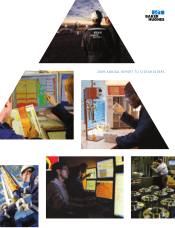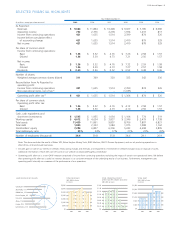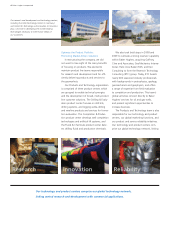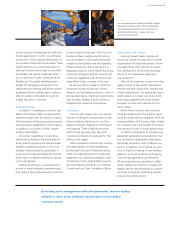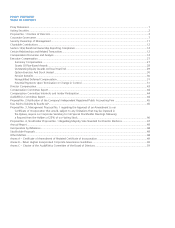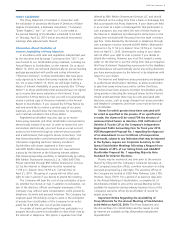Baker Hughes 2009 Annual Report Download - page 4
Download and view the complete annual report
Please find page 4 of the 2009 Baker Hughes annual report below. You can navigate through the pages in the report by either clicking on the pages listed below, or by using the keyword search tool below to find specific information within the annual report.
TO O U R S TO C K H O L D E R S
2009 was an important year of transition
for Baker Hughes. In a difficult market, we
made several strategic moves to enhance our
ability to compete on a global scale and fully
participate in the most significant opportuni-
ties in our industry over the next decade.
During the year, we reorganized to be
more responsive to our customers, relocating
operational leadership from our existing
offices to 32 region and geomarket offices
around the world. We created enterprise-
wide marketing, technology and supply
chain organizations to focus on key market
segments, optimize our product portfolio,
accelerate the pace of product introduction,
and improve our operational efficiency. We
also reached agreement to acquire BJ Services
Company, a provider of pressure pumping
and other oilfield services. BJ Services will
add significant capabilities in pressure pump-
ing and stimulation, closing a significant gap
in our technology portfolio.
In 2009, the world faced the worst global
recession since the Great Depression and
demand for energy fell in step with the
decline in economic activity. Capital spend-
ing by our customers, as measured by the
Barclays Capital Spending Survey, declined
15% in 2009 compared to 2008. The aver-
age U.S. active rotary rig count of 1,090 in
2009 was down 42%, from 1,879 rigs in
2008, and the average international rig
count of 997 was down 8% for the year.
Baker Hughes revenues of $9.66 billion
in 2009 were down 19% from $11.86 bil-
lion in 2008. Net income was $421 million
or $1.36 per diluted share compared to
$1.64 billion or $5.30 per diluted share in
2008. North America revenues declined 31%
and revenues outside of North America fell
9% in 2009 compared to 2008.
The year ended with a bit of good news.
Worldwide revenue increased 9% sequen-
tially in the fourth quarter compared to the
third quarter of 2009 as activity increased
in all geographic regions.
Net income for 2009 was impacted by
charges of $250 million before tax ($0.55
per diluted share), including $138 million
associated with reorganization and sever-
ance, $18 million in acquisition-related costs,
and an increase of $94 million to our allow-
ance for doubtful accounts, as many of our
domestic and international customers strug-
gled in the challenging economic conditions
of 2009. Our operating profit margin for
the year was impacted by the lower activity
levels, significant price erosion, and the extra
costs we carried to ensure a smooth organi-
zational transition. Given the progress we
have made on our transformation, these
additional costs should largely be behind
us as we enter 2010.
During 2009, debt decreased $533 mil-
lion to $1.80 billion, and cash and short-
term investments decreased $360 million to
$1.60 billion as compared to 2008. Capital
expenditures were $1.09 billion, depreciation
and amortization expense was $711 million
and dividend payments were $185 million
in 2009.
Strategic Direction
For the past several years, Baker Hughes
has invested significantly in people, infra-
structure and technology. These investments
served as the foundation for the next set of
strategic actions designed to help us increase
market share and achieve long-term profit-
able growth. We communicated this strategy
to our organization with the visual aid of a
simple pyramid, as depicted on the inside
cover of this annual report.
In brief, increasing market share and
achieving long-term profitable growth
requires Baker Hughes to pursue two related
enterprise strategies: continue to build global
capabilities to serve our customers around
the world, and deploy customized local solu-
tions to meet our customers’ needs in each
geographic market.
We further identified three imperatives
that are critical to the implementation of
these strategies. First, improve our customer
focus, so we can better understand our
customers and proactively meet their needs.
Second, achieve operational effectiveness
and improve our overall cost position. Third,
optimize our existing technology portfolio
and fill strategic gaps, including our reser-
voir engineering capabilities and pressure
pumping services. To implement these imper-
atives, we launched a number of initiatives,
including a major reorganization and tar-
geted acquisitions.
This Annual Report to Stockholders, including the letter to stockholders from Chairman Chad C. Deaton, contains forward-looking statements within the meaning of Section 27A of the Securities Act of 1933, as amended, and Section 21E
of the Securities Exchange Act of 1934, as amended. The words “will,” “expect,” “should,” “scheduled,” “plan,” “aim,” “ensure,” “believe,” “promise,” “anticipate,” “estimate”, “could” and similar expressions are intended to identify forward-
looking statements. Baker Hughes’ expectations regarding these matters are only its forecasts. These forecasts may be substantially different from actual results, which are affected by many factors, including the pending BJ Services acqui-
sition, and those listed in ”Risk Factors“ and “Management’s Discussion and Analysis of Financial Condition and Results of Operations” contained in Items 1A and 7 of the Annual Report on Form 10-K of Baker Hughes Incorporated for its
year ended December 31, 2009. The use of “Baker Hughes,” “our,” “we” and similar terms are not intended to describe or imply particular corporate organizations or relationships.
Chad C. Deaton
Chairman, President and
Chief Executive Officer
2 Baker Hughes Incorporated

